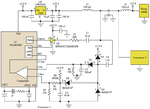ando1
Newbie level 4

Hi,
I am new to the forums as I just found it while researching a fix for my Sonos connect:amp. I found a blown cap on the logic board and need help identifying the value and type so I can order a replacement. Many thanks.
Andy
I am new to the forums as I just found it while researching a fix for my Sonos connect:amp. I found a blown cap on the logic board and need help identifying the value and type so I can order a replacement. Many thanks.
Andy











